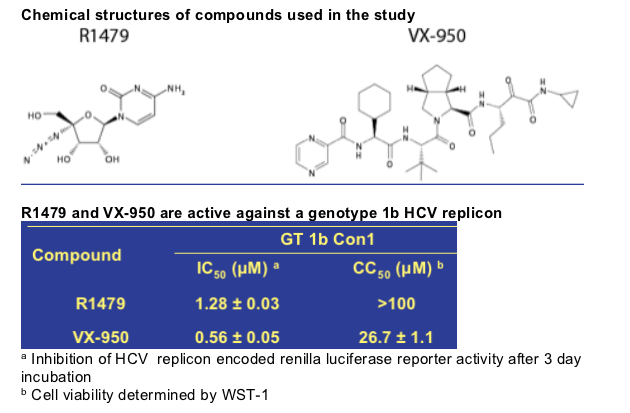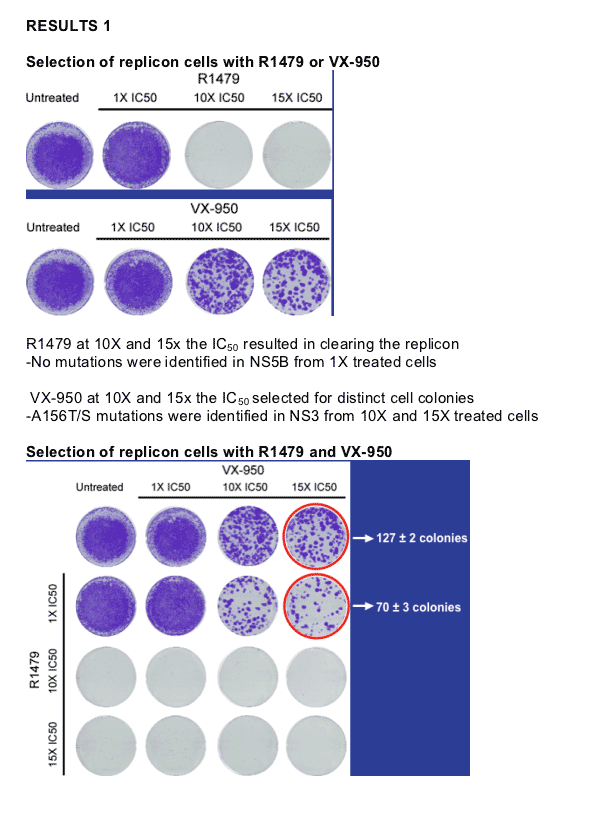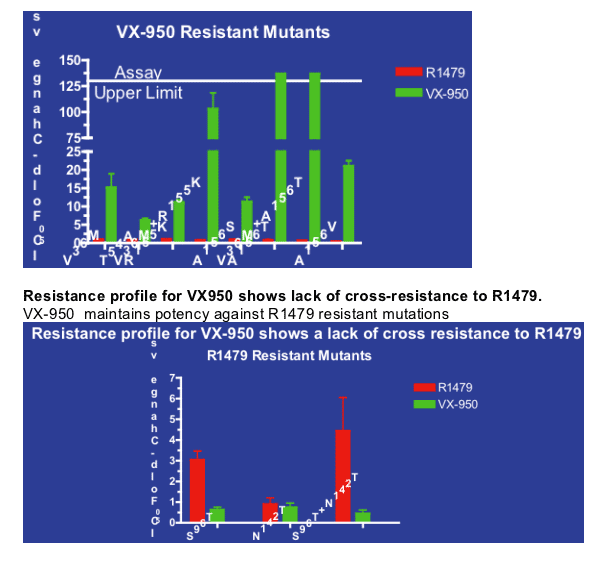 |
 |
 |
| |
In vitro Resistance Selection to the HCV Nucleoside Polymerase Inhibitor R1479 (R1626) and to the Protease Inhibitor VX-950
|
| |
| |
Reported By Jules Levin
EASL, April 2007, Barcelona, Spain
M. McCown, S. Rajyaguru, J. Symons, N. Cammack and I. Nájera
Roche Palo Alto LLC, Viral Diseases Therapeutic Area, Palo Alto, CA, USA
Prior studies show resistance to HCV protease inhibitor VX950 emerge quickly after starting therapy when ir is used as monotherapy. But when used in combination with Pegasys+ribavirin, resistance was prevented and undetectable HCV viral loads were achieved. This study shows R1626, the Roche HCV polymerse inhibitor, and VX950 are not cross-resistant, so R1626 plus Vx950 can be a potent combination that can prevent VX950 drug resistance from emerging.
AUTHOR CONCLUSIONS
Replicon cells selected in the presence VX-950 acquired mutations in the NS3 coding region A156T/S (as previously reported), while selection with R1479 cleared the replicon
-Indicates that the genetic barrier to resistance may be higher for R1479 than VX-950
The in vitro selection of the VX-950 resistance mutations A156T/S correlates with the resistance mutations identified in vivo
In combination with R1479 the number of VX-950 resistant colonies was decreased
-Indicates that combining R1479 with VX-950 may suppress the generation of resistance to VX-950
R1479 maintains potency against clinically relevant VX-950 resistance mutations
VX-950 maintains potency against R1479 resistance mutations
These data support further investigations into the potential clinical benefit of combination therapies
INTRODUCTION
--The Hepatitis C virus (HCV) is a positive-strand RNA virus from the Flaviviridae family
--The HCV RNA genome is 9.5 Kb in length and is translated into 10 structural and non-structural viral proteins
--The only available therapy is pegylated-IFN in combination with Ribavirin
--Approximately 50% of the treated HCV Genotype 1 infected patients obtain a sustained viral response
--New antiviral treatments are required
--Two novel inhibitors of HCV replication are R1479 (NS5B polymerase inhibitor) and VX-950 (NS3 protease inhibitor)
--R1626 (prodrug of R1479) and VX-950 have both demonstrated in vivo efficacy in chronically infected HCV patients
--Given the HCV heterogeneity, development of antiviral resistance is a distinct possibility that must be addressed
--In this study we analyzed the in vitro development of resistance to R1479 and to VX-950, both individually and in combination

METHODS
The stable GT1b (Con1) subgenomic replicon was treated with R1479 or VX-950 for three weeks at 1X, 10X, and 15X their respective IC50's. The cells were then stained with Crystal Violet or the replicon RNA was extracted for sequencing of NS5B and NS3.
The mutations observed after selection, as well as, previously identified R1479 or VX-950 resistance mutations were engineered into the transient HCV replicon and tested for sensitivity to R1479 and VX-950.

The combination of 1X R1479 with either 10X or 15X VX-950 reduced the number of selected colonies.
The combination of 10X or 15X R1479 with VX-950 resulted in clearing the replicon.
RESULTS 2
Resistance profile for R1479 shows a lack of cross resistance to VX-950
R1479 maintains potency against VX-950 resistant mutations. The horizontal letters to the left say Fold Change

|
| |
|
 |
 |
|
|